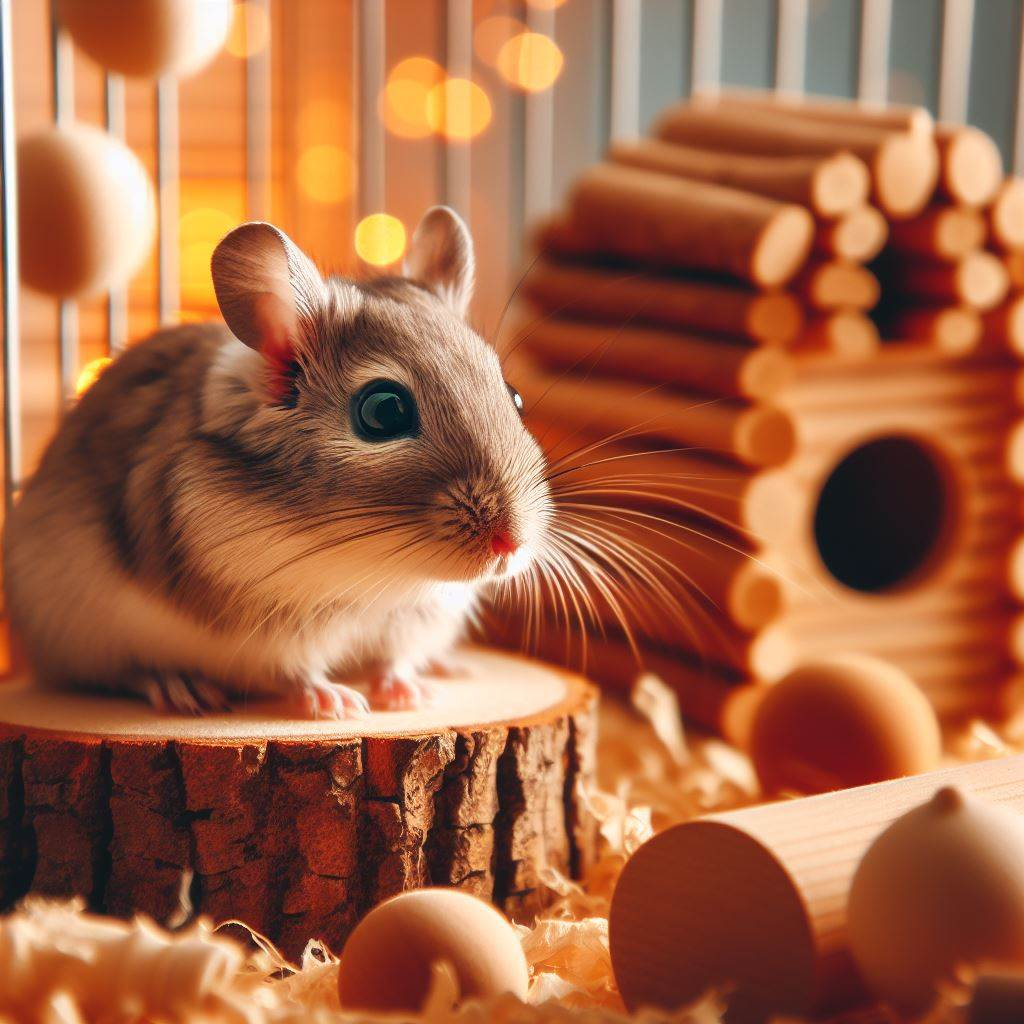Whenever I see those busy little creatures happily rolling and digging in fresh bedding, my heart fills with warmth. As a long-time pet enthusiast who has cared for these adorable creatures, I have done extensive research on choosing bedding that is both friendly and safe for them. However, among the various bedding options, sawdust as bedding has always been a topic of debate. Many novice pet owners may not see any difference but are unaware of the potential health risks this choice may pose to gerbils.
Just as we carefully select furniture for our homes, choosing bedding for gerbils requires meticulous attention to detail. Improper choices may lead to a range of health issues, especially those lurking in fine dust particles. Coupled with the wide variety of bedding available on the market, ranging from untreated sawdust to specialized pet products, the plethora of options can be overwhelming. Next, I will share some insights and recommendations on selecting gerbil bedding, hoping they will help you create a comfortable and healthy living space for your little companions.
Respiratory Issues Caused by Sawdust Bedding:
Gerbils are charming small pets, but their tiny bodies also mean extremely fragile health conditions, especially regarding the respiratory system. As a long-time enthusiast studying gerbil behavior, I have noticed that sawdust bedding tends to produce a large amount of particles and dust during use. These seemingly insignificant dust particles pose a threat to the lung health of gerbils.
Sometimes, even the slightest irritation can cause allergies and respiratory discomfort in gerbils. The tiny particles in sawdust float in the air, and when gerbils are busy digging or playing, these particles can be inhaled into their respiratory tract. Over time, they can lead to respiratory irritation or even more severe breathing difficulties and chronic respiratory diseases.
Itching skin, sneezing, runny nose, or breathing difficulties are all signs of respiratory problems in gerbils. When these symptoms are noticed, pet owners must take prompt action to avoid gerbils being in an unhealthy environment for an extended period. Therefore, in addition to being vigilant to these warning signs, choosing suitable bedding is also a crucial aspect of prevention.
Recommendations for Safe Bedding Selection:
Whether for their comfort or health, choosing suitable bedding for gerbils is always a matter that must be carefully considered during pet care. As early as when I first owned these furry little creatures, I deeply realized the importance of avoiding harmful materials. What we need is a material that does not produce dust and does not easily cause allergic reactions, thus protecting the delicate respiratory tract of gerbils from harm.
Fortunately, there is no shortage of high-quality bedding options on the market. I personally prefer using a mixture of uninked cardboard and other gentle materials. Uninked cardboard contains no ink residues that may cause respiratory problems, and its moisture absorption makes it easy to clean daily. At the same time, uninked kitchen paper towels are also a good choice, as they are both safe and affordable. However, regardless of the type of paper used, it must be ensured that it is uninked, unscented, and unbleached.
In addition, natural hay can be used not only as a primary food source for gerbils but also as bedding because it is quite soft and easy to decompose. Furthermore, considering aesthetics and cleanliness, using a layer of stone material as the cage bottom, combined with an appropriate amount of soft bedding, can keep the gerbil’s activity area clean and easy to maintain.
Every pet owner should consider these factors when choosing bedding, and make the most appropriate decision based on the specific needs and habits of their pets. Providing gerbils with a safe and comfortable living environment not only promotes their health but also establishes a deeper emotional bond between them and their owners.

Difference Between Sawdust and Pet Store Shavings:
After several attempts and research on various types of bedding, I found that not all shavings sold in stores are suitable for bedding our little pet gerbils. Although wood shavings products sold in pet stores are usually advertised as specially designed for pets, responsible pet owners still need to understand what kind of shavings are safe.
To identify safe shavings for gerbils, we need to pay attention to several key points. First, ensure that the shavings are unprocessed and untreated chemically, especially avoiding the use of pine and cedar shavings containing phenolic compounds, as their volatile organic compounds may harm gerbil respiratory tracts. Additionally, good shavings should have low dust and good water absorption, which can reduce the occurrence of respiratory problems and facilitate cleaning.
Sometimes, even shavings sold in pet stores may be confused with ordinary sawdust. An essential task is to learn to distinguish these products. I suggest carefully reading the packaging labels when purchasing, looking for information about the source and processing of the products. If possible, choose dust-free or low-dust products, which are crucial for controlling the level of dust in the cage.
Of course, before making a selection, you can also consider asking the store staff personally or seeking feedback from other pet owners. Try to understand their experiences with specific brands or types of shavings. Additionally, valuable advice can also be obtained from online pet communities or forums.
Gerbil Allergic Reactions and Preventive Measures:
As a gerbil owner, I always pay attention to their health because they are extremely sensitive and prone to allergic reactions for various reasons. These reactions may be caused by food, bedding, or other irritants in the environment, so observing and responding to these signals promptly is essential.
For example, one time, I noticed that my little one had swollen eyes, trembling body, and after careful observation, I realized that it had an allergic reaction to the newly replaced sawdust bedding. This immediately raised my alert, and I quickly replaced the bedding with uninked printed paper that had been used before without adverse reactions. Soon, my gerbil’s symptoms improved. This simple change taught me how important it is to change bedding appropriately to ensure pet health.
Another effective strategy to prevent gerbil allergies is to maintain a set of standard cleaning and disinfection procedures. Regular cleaning can control the accumulation of dust and potential allergens in the cage, significantly reducing the risk of allergies. I clean the cage at least once a week and replace the bedding to ensure their living space is fresh and comfortable.
Moreover, frequent ventilation is also a good way to reduce dust and allergens in the cage. Ensure that the gerbil’s living environment has good air circulation and avoid excessive humidity, as a damp environment may promote mold growth, increasing the health risks for pets.
To further understand the allergens of pets, we can also seek help from veterinarians for allergen testing. Ensure that we do not inadvertently introduce potential allergy hazards to our beloved pets. Through these simple and meticulous measures, we can maximize protection for our fragile little companions from allergies.

Ideal Gerbil Bedding
Having gerbils as pets also means creating a comfortable and safe habitat for them. Bedding is the foundation of the gerbil cage environment, which not only needs to attract gerbils but also meets their physiological and behavioral needs. The wide variety of gerbil bedding options on the market can be overwhelming, with each type of material having its distinct advantages and disadvantages. Here, I will detail the different types of gerbil bedding and provide some practical suggestions.
-
Wood Shavings Bedding: A classic choice, inexpensive, but not all
-
wood shavings are suitable for gerbils. Pine and cedar shavings should be avoided due to the phenolic compounds they contain, which can harm gerbil respiratory systems.
-
Paper Bedding: This is a choice I personally favor because it is soft, absorbent, and harmless to gerbils. However, the downside is that it tends to get wet relatively easily and requires frequent replacement.
-
Fabric Bedding: An environmentally friendly choice that can be reused, but requires regular cleaning and maintenance to keep it dry, as it may harbor bacteria.
When choosing bedding, we must also consider individual differences among gerbils, as some may be allergic to certain materials. As mentioned earlier, we need to closely observe the gerbils’ reactions and choose the bedding that best suits them.
Now, let’s take a look at the potential benefits of using natural materials as bedding:
-
Natural fibers such as hemp and cotton are breathable and absorbent, providing gerbils with a soft sleeping bed.
-
Natural materials are often more environmentally friendly than synthetic materials. While providing pets with a comfortable life, we are also contributing to protecting the earth.
Finally, I want to share some creative bedding mixing schemes:
-
You can use uninked printed newspapers as the bottom layer of bedding, and lay soft fabrics or unbleached paper towels on top.
-
Alternatively, mixing different particle sizes of wood shavings, with smaller particles at the bottom to absorb urine and larger particles at the top to reduce dust.
-
Additionally, placing non-toxic plant fiber bedding on top of wood shavings or paper strips can provide a more natural environment.
-



